Looking for the perfect heirloom tomato with incredible flavor? Then you need to consider growing brandywine tomatoes!
Brandywine tomatoes are the perfect combination of massive size and big flavor. These large beefsteak-like slicing tomatoes are well known as being one of the best tasting tomatoes available on the market – And for good reason!
They feature a sweeter flavor than traditional tomatoes and have less acid. They are perfect for eating fresh, adding to salads, or topping onto your favorite burger.

These juicy tomatoes are heirloom cultivars, meaning they are open-pollinated and not hybrids. Unlike hybrid varieties of tomatoes, you can save the seeds of heirloom tomatoes to use again the next growing season.
Not only will saving seeds keep you in a constant supply of amazing tomato plants every summer, but it will save you money each year as well. A huge win-win for most home gardeners!
Varieties of Brandywine Tomatoes – Growing Brandywine Tomatoes
The exact origin and date of brandywine tomatoes are unknown. However, they appeared in seed catalogs as far back as the late 1800s. The seeds have continued to be passed down from generation to generation since that time and are typically only grown by backyard gardeners and small growers.
Brandywine tomatoes can be found in many different colors, including red, pink, yellow, and even a newer black variety. They feature a more asymmetrical shape with ridges around the top. They have potato-leaved foliage and lack the serrated edges that typical tomato plants feature. (Product Link: Heirloom Brandywine Tomato Seeds)
Just one brandywine tomato can weigh as much as two pounds, but most average around 12 to 16 ounces. They are considered to be indeterminate tomatoes, which means that the plants will keep on producing and growing up until they are topped or the first frost.

Due to their massive fruit and the fact that they can grow over nine feet tall, brandywine plants must be supported by trellises or tomato cages.
How To Plant, Grow, And Maintain Brandywine Tomatoes
Planting Brandywine Tomatoes – Growing Brandywine Tomatoes
Brandywine tomatoes are hardy in growing zones 3 through 9. You can either purchase them as transplants at local nurseries or garden centers, or you can start your own seeds indoors.
Starting seeds indoors is a great option since you can actually save heirloom tomato seeds from year to year. Not only is starting seeds indoors simple and easy, but it can save you money in the long run and give you more options for growing different plant varieties many nurseries might not grow.
Keep in mind that it takes brandywines about 90-100 days from the point of planting to the point of harvesting. For more in-depth information on starting your own brandywine tomato seeds indoors, check out “How To Start Tomato Seeds Indoors.”
Planting Transplants
Brandywine tomatoes require full sun locations with at least 6 to 8 hours of sun each day. Choose a location that has nutrient-dense, well-draining soil. You can amend the soil with plenty of compost to help add in more organic matter and increase drainage if needed.
Wait until the threat of frost has passed before placing transplants into the soil outside. For best results, wait until the soil reaches temperatures of 65º Fahrenheit or warmer before transplanting.

Create a hole with a post-hole digger or shovel that is several inches deeper than the plant’s rootball. With all tomato plants, you want to plant them as deep as possible. This is especially true with brandywines.
The entire stem of a tomato plant is capable of creating new roots. The deeper you plant it, the more support and anchoring the tomato plant will have and the better chances are that it can support its tall and heavy growth.
Place the plant in the hole, backfill with additional soil and compost, and water the plant deeply. Space additional plants between 18-36” apart. Add your tomato supports or cages now so you don’t damage any established roots down the line.
Long-Term Care – How To Grow and Maintain Brandywine Tomatoes
Watering
Proper watering is key to a healthy heavy-producing tomato plant. After you plant the tomato, water it almost daily. After the plant becomes established, cut back on watering so you are giving it about 1-2” weekly. Be sure to consider the amount of rainfall you have received each week as well in the weekly total.
Once the brandywine plant starts to put out fruit, be sure to keep up with the consistency of watering. A period of dry conditions followed by a large amount of watering can cause cracking and swelling of the fruit. Inconsistent watering can also cause issues with blossom end rot.
To see if your plants need water, don’t go by the surface soil appearance only. Instead, check down a few inches deep where the roots will be located. A lot of times, the soil surface might be dried out but there is still plenty of water deep down by the roots.

Water plants at the base instead of watering overhead if at all possible. This will help to avoid getting too much moisture on the foliage of plants.
Mulching
It is a good idea to mulch heavily around brandywine tomato plants when growing them. Use organic mulch like straw, grass clippings, or shredded leaves. Keep the mulch about 2 to 3 inches away from the stem.
The mulch will prevent weeds from competing for resources. In addition, it will also help the soil to retain moisture as well as regulate the soil temperature. Lastly, it can help prevent soil-borne diseases from splashing onto plants when they get watered.
Fertilizing
Tomatoes are considered to be heavy feeders, and brandywines are no exception. The key to productive plants that aren’t all foliage and growth is fertilizing often and in low doses.
There are many different types of fertilizers on the market that you can use. If you choose the commercial route, be sure to opt for liquid fertilizers for the best results. Solid fertilizers can be applied less often but they can give plants too much foliage growth all at once.
You can also fertilize brandywine tomatoes with compost tea. This 100% organic and natural mixture of aged compost and water is perfect for powering tomato plants.

Wait to start fertilizing until transplants have been in the ground for about two weeks. Use about an eighth of a gallon for the first few couple of weeks. Increase to around a quarter to half a gallon per plant thereafter.
Apply the liquid fertilizer every 10 to 14 days. Stop fertilizing once the brandywine plants have started to ripen their first set of fruit.
Pruning
It is best to prune brandywine tomato plants when growing them since they are indeterminate plants.
All tomato plants will start to put out what’s called “suckers.” These branches appear in the crook or armpit of a leaf axils (the “V” between the main stem and a branch). If left to grow, it will turn into its own main branch with fruit and suckers.
While that might sound like a good thing, the suckers will start to take too much resources and energy away from the main stems and in turn, reduce fruit production and size. In addition, your tomato plants can become rather unruly and more susceptible to diseases and pests if left unpruned.
Also, prune all stems off the bottom 12 to 18 inches of the plant. This will help to increase the airflow as well as keep foliage off of the soil.

Harvesting
Due to their long growing season, you will typically harvest brandywine tomatoes a bit later than others. Depending on the variety of brandywine tomatoes you are growing will depend on the color of the fruit before harvesting. For example, a pink brandywine will never turn the traditional bright red.
Instead of simply pulling the tomato off the vine, twist the fruit off instead. Or, use a pair of sharp, clean pruners and snip the stem off just above the fruit. Since they are indeterminate tomatoes, the more often you harvest, the more resources the plant can put towards creating new blooms and fruit.
You also do not need to wait until the fruit is 100% ripe before harvesting. You can allow the fruit to ripen off the vine as long as it has started ripening about a quarter of the way.
While you may not get a massive harvest with brandywine tomato plants, the fruit that does grow will be large, juicy, and oh-so-delicious! Just don’t forget to save some of those seeds while you are slicing into that one-pound-plus fruit for next year’s garden!
